Super Mario Bros. - 1985
| Year: | 1985 |
| Original platform: | Famicom/Nintendo Entertainment System |
| Brief description: | Jump-and-run platform adventure game |
| Number of players: | One or two |
| Developers/contributors: | Nintendo |
Nintendo had already made their breakthrough onto the video gaming world stage in 1981 with Donkey Kong, the jump-and-run adventure game that established the platform game genre. In this kind of game, the player must navigate their character from one platform to the next by running, jumping or climbing. Developed for both the arcade environment and for various Nintendo game consoles, Donkey Kong was the game in which the character Mario made his first appearance. Mario made his next significant appearance in the Nintendo arcade game Mario Bros., released in 1983, this time accompanied by his younger brother Luigi. Having begun his existence in Donkey Kong as a carpenter, Mario was now an Italian-American plumber.
In Mario Bros., the protagonists are creatures that inhabit the sewers beneath New York. Mario must eliminate the creatures by flipping them over onto their backs and then kicking them away (Mario's brother Luigi is only involved in the two-player mode). Each time a creature is dispatched in this way, coins appear that can be collected by the player's character to acquire bonus points. Additional hazards appear in the form of fireballs that frequently move across or bounce around the screen, and icicles that form underneath platforms and have a tendency to fall from time to time.
Mario Bros. was not a huge commercial success, either in Japan or North America, perhaps partly due to the video game market crash of 1983. Nevertheless, the game subsequently found its way onto a number of different hardware platforms, including the Nintendo Entertainment System (NES), and survives in one form or another to this day. Perhaps more importantly, it enabled Nintendo's developers to try out a number of innovative ideas which were subsequently incorporated into the Super Mario Bros. game.
The game with which Nintendo of America (NoA) had gained their foothold in the North American video gaming market, Donkey Kong, had achieved its success largely due to the efforts of game designer Shigeru Miyamoto. Nintendo president Hiroshi Yamauchi obviously had considerable faith in the talents of Miyamoto as a game designer, because he gave him his own research and development division, and tasked him with developing the games that would also spearhead Nintendo's next foray into the North American market. Despite the relative lack of success of Mario Brothers, Miyamoto continued to develop games featuring the Mario character. This obviously included Super Mario Bros., for which he was both producer and director. His faith was more than justified when Super Mario Bros. became a huge success, first in Japan, and later in North America.
By 1985, despite the severe recession that had occurred in the North American video gaming industry in 1983, Nintendo were ready to attempt to build on their earlier success. The Famicom (Nintendo's Family Computer), an 8-bit home video game console, had been released in 1983 in Japan and was a huge success there. Nintendo hoped to repeat this success in North America with the Nintendo Entertainment System, which was essentially a version of the Famicom developed for the North American market.
There was, however, a problem. American retailers, who had suffered substantial losses as a result of the 1983 video game crash in terms of unsold games and game consoles, were unwilling to risk further losses. Nintendo therefore decided to take a huge gamble themselves. They agreed to supply the Nintendo Entertainment System to stores on the understanding that they would buy back any unsold stock. They even undertook to set up in-store displays, and demonstrate the capabilities of the new system to potential customers. An initial launch of the NES subsequently took place during the last quarter of 1985, although it was limited to retail outlets in and around the city of New York. The results were sufficiently encouraging for Nintendo to expand its marketing efforts to the rest of the USA.
The cartridge version of Super Mario Bros. was released in Japan for the Famicom in September, 1985, and immediately gained enormous popularity. It was released the following month in North America for the Nintendo Entertainment System. Although the game was not initially part of the NES game console package, Nintendo must have recognised its potential for increasing NES console sales because by the end of 1986 they were offering it as part of an optional system bundle. Hiroshi Yamauchi was fully aware that even the best game console hardware in the world is only as good as the games available for it, and he believed that Miyamoto's Super Mario Bros. would become as popular in North America as it already was in Japan. Sure enough, sales of Nintendo's home gaming console increased dramatically.
Super Mario Bros. was the game for an entire generation of video gamers, and it lives on in one form or another to this day. The original game can be played on the PC under Windows using an emulator. The one we used for the screenshots on this page is the open source NES/Famicom emulator Nestopia, which was developed for Windows by Martin Freij. There are also ports available for Linux and Mac OS X. If you want to try the emulator for yourself, you can download it from the home page at:
http://nestopia.sourceforge.net/
In order to use the emulator to play a game, you will need a copy of the game's ROM (legally acquired, of course). The opening screen allows the player (or players) to select either the one-player or the two-player version of the game. If the one-player version is chosen, the player controls Mario, and Luigi does not feature at all. If the two-player version is chosen, player number one controls Mario and player number two controls his brother Luigi. The two characters have identical abilities, and the sprites used for Mario and Luigi appear to be identical except for the colour of their overalls. Each player plays until they lose a life or the game is over, whichever comes first. Status information is displayed at the top of the screen throughout the game, including the current player's score, the number of coins collected so far, the current level, and the time remaining in the current level.
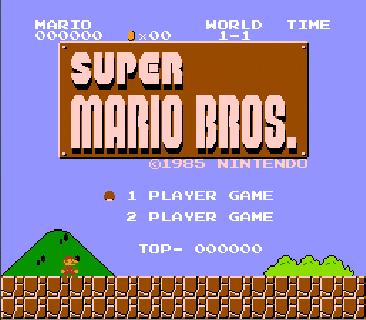
You can choose the one player or two player game
The ultimate objective of the game is laid out in the game manual in the following mission statement:
OBJECT OF THE GAME/GAME DESCRIPTION
One day the kingdom of the peaceful mushroom people was invaded by the Koopa, a tribe of turtles famous for their black magic. The quiet, peace-loving Mushroom People were turned into mere stones, bricks and even field horse-hair plants, and the Mushroom Kingdom fell into ruin.
The only one who can undo the magic spell on the Mushroom People and return them to their normal selves is the Princess Toadstool, the daughter of the Mushroom King. Unfortunately, she is presently in the hands of the great Koopa turtle king.
Mario, the hero of the story (maybe) hears about the Mushroom People's plight and sets out on a quest to free the Mushroom Princess from the evil Koopa and restore the fallen kingdom of the Mushroom People.
You are Mario! It's up to you to save the Mushroom People from the black magic of the Koopa!
In order to achieve this objective, Mario must overcome many obstacles, and either avoid or eliminate a variety of enemies. Needless to say, defeating one of these enemies earns the player points, whereas simply avoiding them doesn't. The game is over when the player completes all of the levels, runs out of time, or loses all their lives.
Many of the recurring features of the game are introduced in the game's first level. The first enemies encountered in this level are the Goombas. They look like mushrooms, and are encountered throughout the game. As with most of the enemies he faces, If Mario runs into a Goomba he will lose a life (unless he is currently a powered-up version of Mario, in which case he will simply revert to being the small version of Mario). They move backwards and forwards relatively slowly, however, and Mario can eliminate them simply by jumping on them. In fact, this is a tactic he can use to defeat most of his enemies.
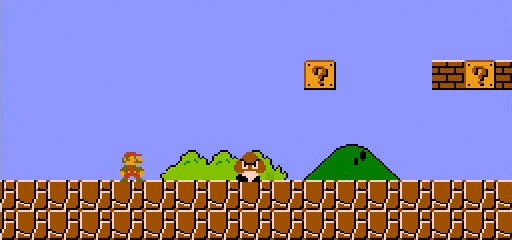
The commonest, most easily defeated enemy is the Goomba
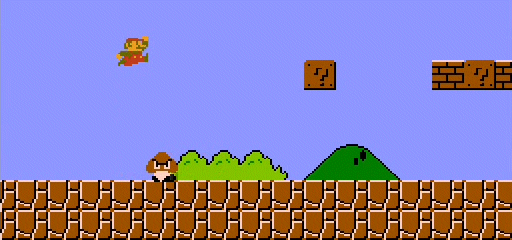
Mario can defeat a Goomba simply by jumping on it
You may have noticed the blocks, apparently defying gravity, that are suspended in the sky. Some of them simply look like sections of a brick wall, while others are marked with a large question mark symbol. If Mario jumps up and makes contact with one of the latter, a special game item will be released. Usually, the item will be a coin, which is worth two hundred points. Coins can sometimes be hidden behind normal blocks as well. Collecting a hundred coins gets you an extra life.
Sometimes, the item will be something a little more interesting that can bestow special powers - for a while, at least. A Super Mushroom, for example, is worth a thousand points, and turns Mario into a bigger version of himself (a Super Mario, in fact!) providing he can make contact with it once it has been released. There is also a 1-Up Mushroom which gives Mario an extra life, although these are quite rare.
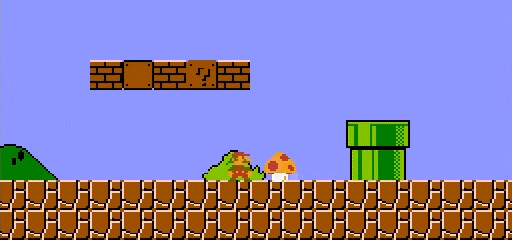
A Super Mushroom is worth 1,000 points, and makes Mario bigger
Once in his Super Mario form, Mario can encounter a Goomba without losing a life, although if he does encounter one he will shrink back down to his normal size and be vulnerable again. Another advantage of being in this larger form is that Mario can jump up and smash the brick blocks to earn extra points.
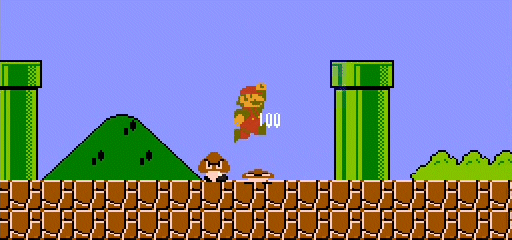
Big Mario can survive an encounter with an enemy
Mario can also earn extra points by defeating more than one enemy at a time, usually by jumping on them, although the timing has to be just right or he could run into an enemy instead and lose a life. He must also be careful not to fall down one of the many gaps that appear on each level. That too will result in him losing a life, whatever form he is in.
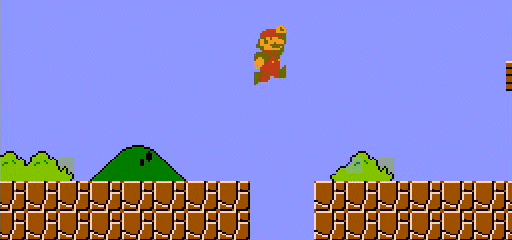
Mario must jump over any gaps he encounters
The second enemy Mario will encounter on the first level will be the Koopa Troopa, which is a small turtle that retreats into its shell when jumped on. Once in this state, Mario can kick the Koopa Troopa along the ground to eliminate other enemies (including other Koopa Troopas). Mario must be careful not to get in the way of one of these shell projectiles himself, however, since they will bounce back off walls and other obstacles. In his large form, he will revert to his small form if struck by a shell, but if struck whilst in his small form he will lose a life. The Koopa Troopas are usually green, but some of them are red. The red ones behave slightly differently in that they will turn back from the edge of a gap if they encounter one, whereas the green ones will just keep going and fall in.
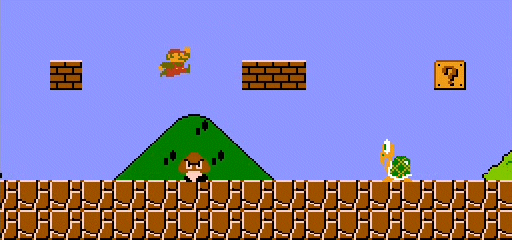
The second enemy Mario encounters is the Koopa Troopa
One of the really useful items Mario can discover hiding behind a block is the so-called Starman (presumably because it is shaped like a star). If Mario manages to touch a Starman, he earns an additional one thousand points and becomes invincible for a short time (although he can still lose a life by falling down one of the many gaps). In this state, he can simply run through any enemies he encounters and they will be eliminated.
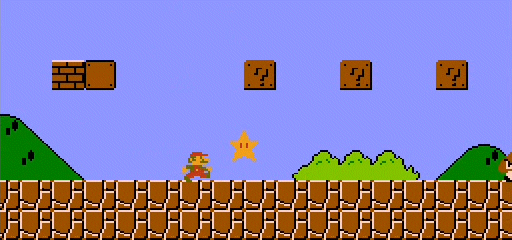
The Starman gives Mario 1,000 points and temporary invincibility
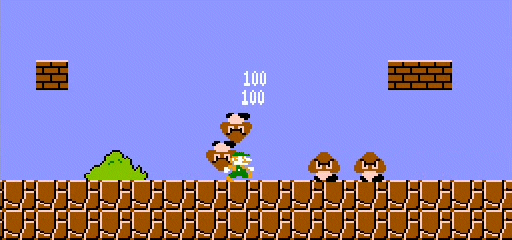
A Starman-powered Mario can simply run through enemies to eliminate them
Another very useful item encountered in this first level is the Fire Flower. Like other special items in the game, it can be found hiding behind one of the brick blocks. Although it looks fairly innocuous, if Mario can get hold of this plant he not only gets one thousand extra points, he also acquires the ability to throw fire balls. If he runs into an enemy in this powered-up state, he does not lose a life, but reverts back to being small Mario.
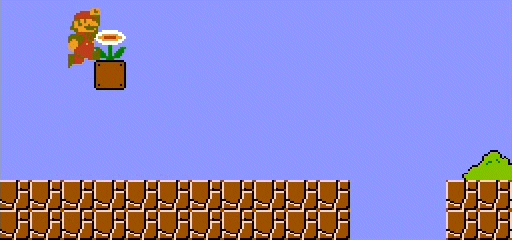
The Fire Flower gives Mario 1,000 points and the ability to throw fireballs
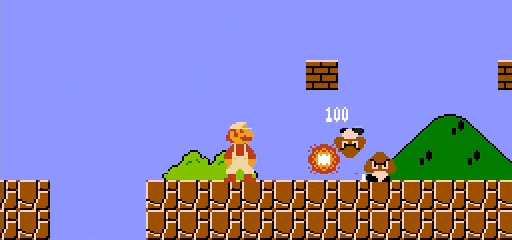
Mario can use fireballs to eliminate enemies
In each of the thirty-two levels in the game, Mario must deal with all of the enemies, obstacles, and pitfalls, and get to the end of the level. There, he will encounter a flagpole standing before a small castle. The flag flying on the flagpole is that of King Bowser Koopa, the king of the Koopa tribe (usually referred to simply as Bowser). Mario must take down the flag by jumping onto the flagpole, after which he will enter the castle, and the level is complete. The higher up the flagpole Mario manages to jump, the more points he will earn. Play will continue straight into the next level without a break although you can of course pause the game if you need to. You can also save the game at any point on the emulator version, although this was apparently not possible on the original NES console.
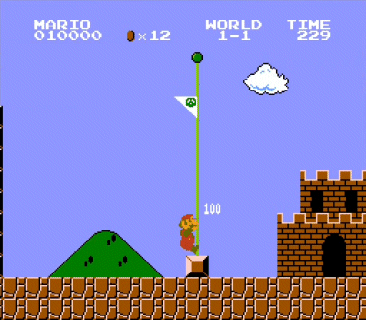
When Mario reaches the flagpole, the level is complete
The Super Mario Bros. playing environment is organised into eight "worlds". Each world consists of four levels. To complete each level, Mario has to overcome or avoid the enemies, pitfalls and other obstacles in that level, and reach the flagpole at the end of the level. Each level, in each world, takes place in one of five different settings. The first level, as we have already seen, takes place in the "Overworld" setting, which as the name suggests is above ground. The blue background used in some of these levels presumably represents the sky, and was unusual for video games of the time. A black background was more often used for video games, as it was thought to reduce eye strain.
The second level of World 1 takes place in the "Underground" setting, and as you might expect uses the more traditional (for the time) black background. A new enemy is introduced in this level - the Piranha Plant. This carnivorous plant lives in pipes, and if Mario is standing on the pipe when it emerges he will lose a life (or revert to his small form if powered-up). He can't kill Piranha Plants by jumping on them.
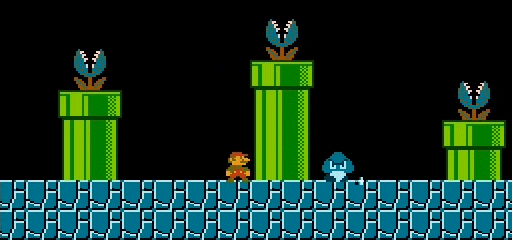
The second level is set underground, and introduces the Piranha Plant
Level two also introduces a new kind of obstacle - the moving platform. The platforms appear in gaps that are too wide to jump over, so Mario must jump onto one of these moving platforms in order to get across the gap. Not too difficult if you can get the timing right - you just need to make sure you don't land safely on the other side, only to run straight into an enemy.
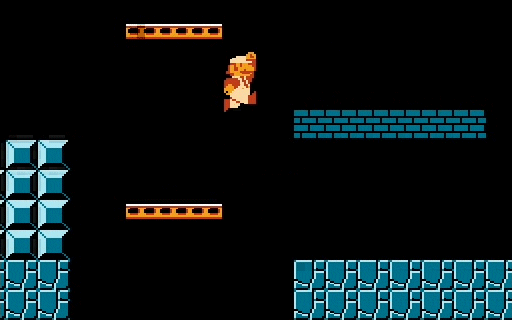
Very wide gaps can only be crossed safely by jumping onto moving platforms
Pipes serve another purpose in the game, apart from providing a home for the deadly Piranha Plant. They act as conduits - for example, between one level and the next. Pipes are also sometimes used to access hidden rooms and levels. Very occasionally, Mario can use one of these pipes to skip ahead to a higher level in the game.
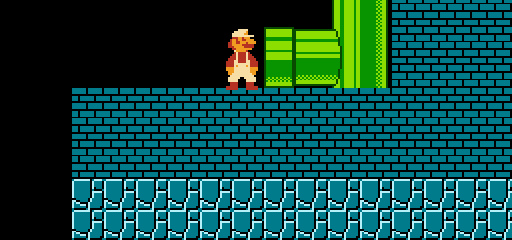
Pipes serve as conduits between different levels, and to hidden game spaces
In level three, we encounter a new kind of environment called the “Athletic” setting, probably because Mario must negotiate platforms set at various heights, sometimes using moving platforms, and all the while avoiding or eliminating the usual assortment of enemies. This setting seems to be an outdoor setting, since there are blue skies and clouds once more.
A new enemy appears here - the Koopa Paratroopa. Like the Koopa Troopas, these creatures are turtles. They look exactly like the Koopa Troopas, except that they have wings and can fly. There are two varieties. The red Koopa Paratroopas fly up and down, but otherwise don't appear to do much. The green Koopa Paratoopas are somewhat more erratic in their behavior, and sometimes fly at Mario without warning. If Mario jumps on a Koopa Paratroopa, regardless of type, it will lose its wings and become an ordinary Koopa Troopa (hitting a Koopa Paratroopa with a fireball has the same effect). It can then be dealt with in the usual way.
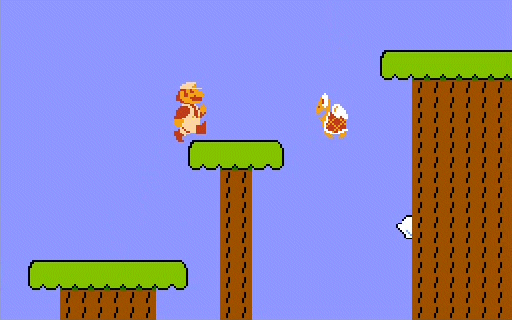
The Koopa Paratroopas are flying versions of the Koopa Troopas
The fourth and final level in each of the eight worlds takes place in the “Castle” setting: As the name suggests, the action takes place within a castle. New obstacles are encountered here, including what appear to be pits full of molten lava that Mario must jump over or suffer a fiery fate. This would normally present no problem, but some of these pits are guarded by a rotating Firebar - essentially a stack of fireballs. The Firebars are found in other locations within the castle as well. They can vary in length, and may rotate either clockwise or anti-clockwise. They are often arranged in tandem in order to make it more difficult for Mario to avoid them. If he touches one, he will lose a life (or, if powered-up, revert to being small Mario).
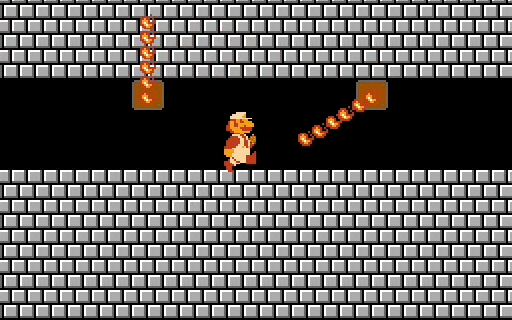
Firebars are present in various locations inside a castle
If he manages to avoid the Firebars, Mario must still watch out for the fireballs that seem to be coming out of nowhere. The source of these fireballs turns out to be a fierce looking creature that looks like Bowser, and who is guarding a bridge over a river of molten lava. It turns out that this is, in fact, a False Bowser - a decoy created by the real Bowser.
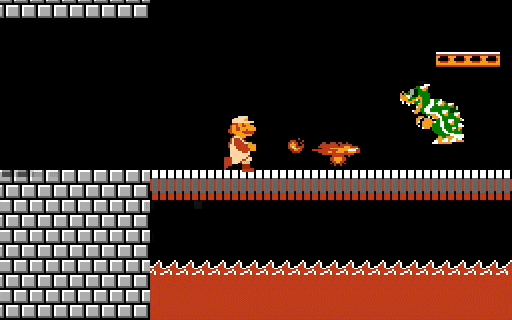
Mario will encounter a False Bowser
Mario must somehow avoid the clutches of this False Bowser, as well as avoiding the fireballs he is unleashing, and get to the other side of the bridge. Alternatively, he can defeat the False Bowser in combat if he has the ability to throw fire balls. Once across the bridge, he can use the axe, which is (rather conveniently) waiting there, to destroy the bridge. Mario must jumps on, or otherwise makes contact with, the axe. This will make the bridge retract towards the left-hand side, causing the hapless False Bowser (assuming Mario hasn't already disposed of him) to fall into the river of molten lava.
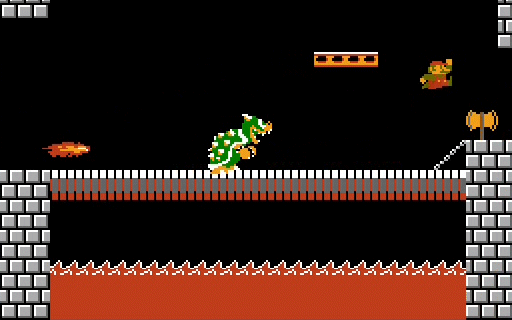
Mario must make contact with the axe to make the bridge retract . . .
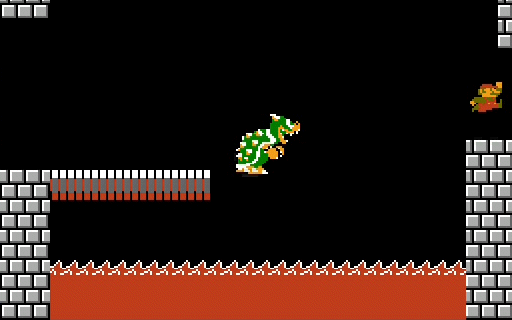
. . . causing the False Bowser to fall into the lava
The “Princess” rescued by Mario in the final level of each of the first seven worlds also turns out to be a decoy, placed there by Bowser. Although each of them expresses their gratitude for being rescued, they are in fact all Mushroom Retainers - described in the game's documentation as “Seven Mushrooms who originally served in the court of Princess Toadstool, but are now under the spell of the evil Koopa King”. Needless to say, the real Princess does not put in an appearance until the last level of the final world!
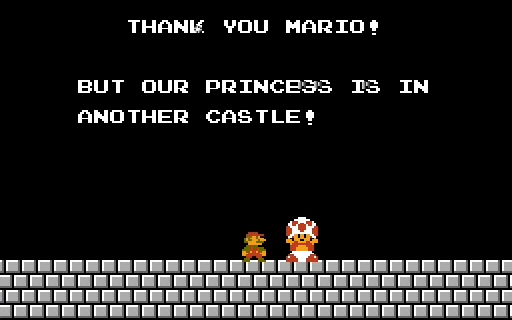
The “Princess” in the final level in Worlds 1-7 turns out to be a decoy
The first level of World 2 is another Overworld level, with enemies we have seen before. One of the features Mario may encounter here, as well as at other locations in the game, is a Beanstalk (sometimes called a Magic Vine), which is hidden behind one of the blocks. The beanstalk grows rapidly, allowing Mario to use it as a ladder to climb up above the clouds. Once there, he can earn extra points by collecting coins. Another new feature, which appears right at the end of this level, is a large spring that Mario must jump on in order to get over the final wall.
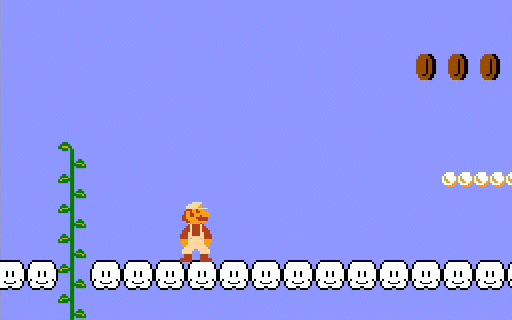
The Beanstalk allows Mario access to the coins hidden above the clouds
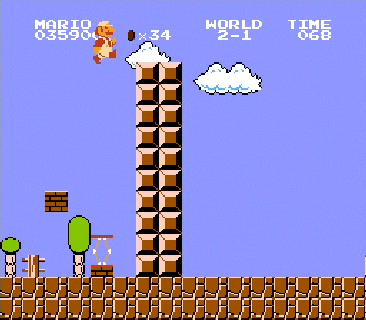
Mario must use the spring to clear the wall at the end of the level
Level two in World 2 introduces a new environment - the “Underwater” setting. This level is actually fairly easy to get through. Mario can swim from the bottom to the top of the water, and although he still needs to avoid any enemies that appear in order to make it through the level, this is not really too difficult. There are two new enemies that appear in this level, both of which will be seen again in later “Underwater” levels. The Blooper is a squid-like creature that tends to chase after Mario. The Cheep-Cheep is some kind of fish, although its lateral fins appear to be able to double up as wings, as we shall see shortly. The Cheep-Cheeps may be coloured red, green or grey.
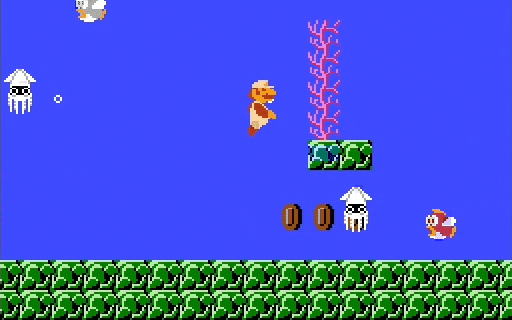
In the underwater levels, Mario must avoid Bloopers and Cheep-Cheeps
The third level in the second world takes place in an “Athletic” setting. There are the usual gaps to jump across, but this time no moving platforms. There are a large number of jumping Cheep-Cheeps however, so Mario needs to be careful in order to avoid them.
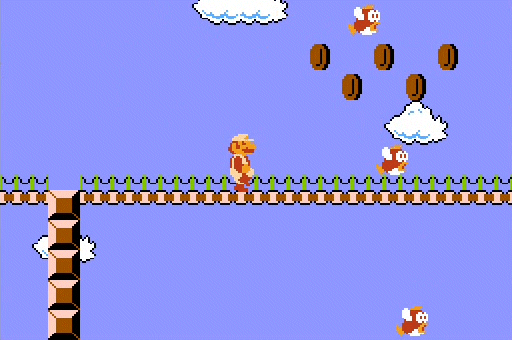
This level has a large number of jumping Cheep-Cheeps
The final level of World 2, as in all of the other worlds, takes place in the “Castle” setting. There is the usual array of Firebars, and at the end of the level, Mario again has to defeat one of the False Bowsers. The only new enemy introduced in this level is the Podoboo. The Podoboos are essentially just big fireballs that jump out of lava pits. If one of them hits Mario he will lose a life (or, if powered-up, revert to being small Mario). They are not all that difficult to avoid, however.
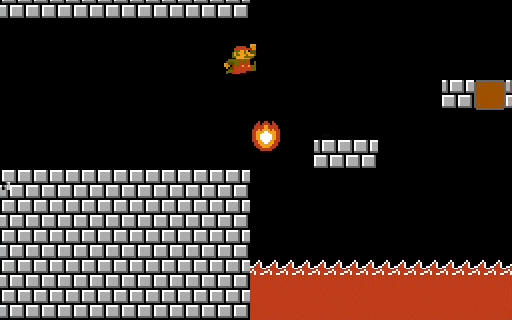
Podoboos are big fireballs that jump out of the lava pits
The first level in World 3 takes place in the "Overworld" setting. This time the action must be taking place at night because, although there are clouds in the sky, the background is black instead of blue. We meet another new enemy here - the Hammer Bros. These are Koopa Troopas that walk upright, usually appear in pairs, and continually throw hammers in Mario's direction. They also occasionally jump.
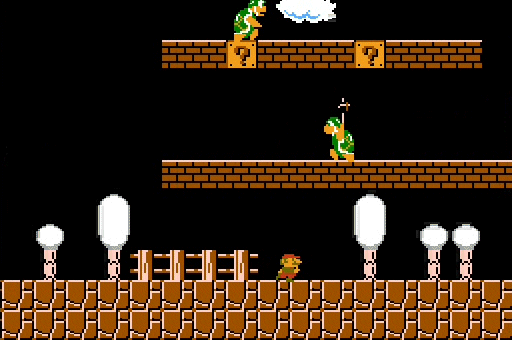
Hammer Bros are Koopa Troopas that walk upright and throw hammers
We meet another enemy for the first time in the first level of World 4. This particular enemy actually takes three different forms. The first of these is the Lakitu, a spectacle-wearing Koopa Troopa that rides along on top of a small cloud. It hovers over Mario, tracking his movements. It also drops Spiny Eggs (the second form of this enemy) at regular intervals, which land in Mario’s vicinity. If one of these eggs touches Mario, he loses a life (or, if powered-up, reverts to being small Mario). Once on the ground, each Spiny Egg will hatch immediately into a Spiny (the third form of this enemy). The Spiny is a small red Koopa Troopa with a spiked shell. Unlike other kinds of Koopa Troopa, Mario can’t kill this creature by jumping on it. If he does so, he will lose a life (or, if powered-up, revert to being small Mario). They can be killed using fireballs, but it’s probably easier to just avoid them.
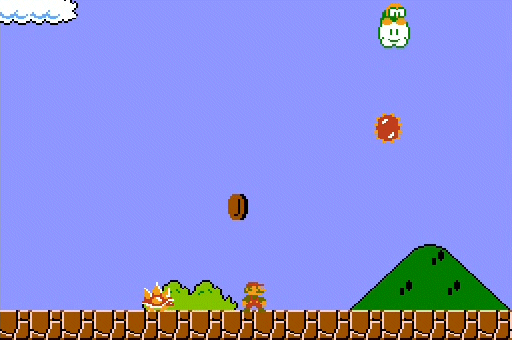
The Lakitu drops Spiny Eggs that hatch into Spinys
Another enemy that appears for the first time in World 4 is the Buzzy Beetle. Like the Koopa Troopa, this is a small turtle that hides in its shell when jumped upon. Unlike the Koopa Troopa, it is immune to fireballs.
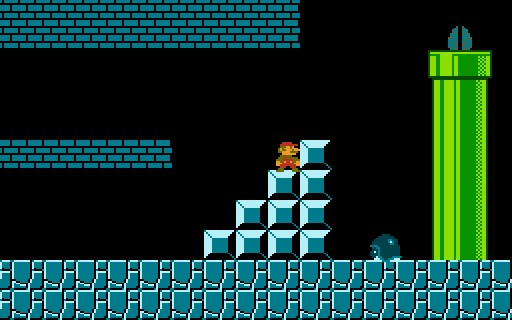
The Buzzy Beetle is a small turtle like the Koopa Troopa, but is immune to fireballs
I always have lots of problems getting past level three in World 4 - I never seem to be able to make the jump onto one of the high platforms (probably due to my extremely poor coordination). I am ashamed to admit that I have sometimes cheated by using the Warp Zone at the end of World 3 to go straight to World 5!
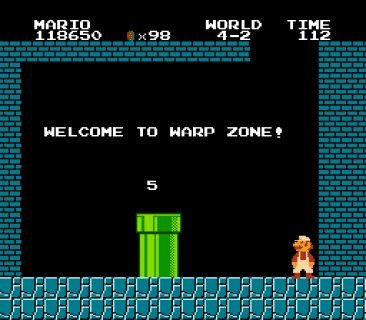
The Warp Zone room at the end of World 3 allows you to bypass World 4
In World 5, Mario encounters the final two enemies (apart from Bowser himself, of course). The first of these is Bill Blaster, a cannon that Mario cannot destroy (although if he gets close enough to it, it will temporarily cease doing what it does most of the time, which is to shoot bullets. These bullets, of which there seems to be an endless supply, are called Bullet Bills, and appear to have eyes and arms. Mario can eliminate them by jumping on them or by running into them when he is in the Starman mode. If a Bullet Bill hits Mario, he will lose a life (or revert to his small form if powered-up).
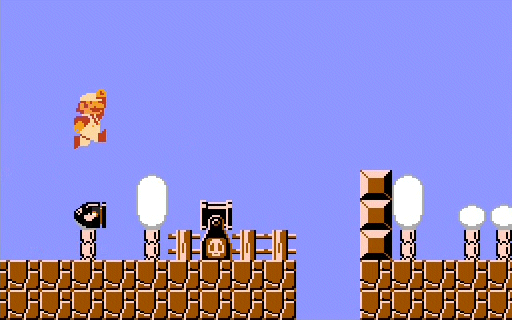
Bill Blaster fires Bullet Bills at Mario at regular intervals
The levels become gradually harder to beat as you get closer to the end of the game and that final confrontation with Bowser, but there are no new enemies after World 5. As usual, the final level of World 8 takes place in the “Castle” setting. In order to get to Bowser, you have to go through at least two pipes and an underwater section in which, somewhat strangely, the main obstacle is a series of Firebars! Once you are through this section, there is a Hammer Bro to overcome before you can finally do battle with King Bowser himself. The King looks remarkably like all the False Bowsers Mario has met previously, except that he is far more heavily armed and thus more difficult to defeat. Once Mario does manage to defeat him, he will finally meet the real Princess Toadstool!
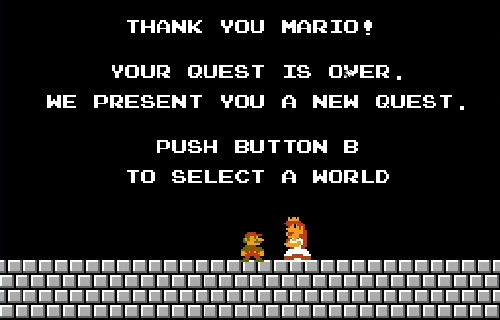
After defeating Bowser, Mario finally meets Princess Toadstool
If you manage to complete the game, you can undertake an additional “quest”. This is essentially just an opportunity to replay a world of your choosing. Don’t expect an easy ride, however, because the level of difficulty increases significantly for the extra levels. In addition to bonus worlds, there are also hidden levels and secret rooms scattered throughout the game, just waiting to be discovered. One of the best-known of these hidden levels (among seasoned gamers, at any rate) is the so-called Minus World. This hidden stage is labeled World -1, and it can be accessed from the second level of World 1 via a hidden warp zone. It is an underwater stage that goes on indefinitely - going through the exit pipe at the end of the level simply takes you back to the start of the level!
What made Super Mario Bros. such a popular game? Probably a number of things. Miyamoto was the creative genius behind it, of course, but he was aided by co-designer Takashi Tezuka, who joined Nintendo in 1984 and at the time of writing is still producing games for them. He and Miyamoto would first produce the design for each level on paper, and then pass it to the programming team - Toshihiko Nakago, Kazuaki Morita and Yasunari Nishida. The action takes place, by design, over a number of screens in each level, as Mario progresses from left to right within a kind of sliding window. This side-scrolling concept was still relatively new, and opened up almost limitless possibilities in terms of making the best use of screen space. In particular it allowed for the development of game backdrops that could extend way beyond the physical borders of the screen, and a much more diverse cast of characters.
The degree to which players can interact with a game is obviously an important factor in determining how well it will be received. In the case of Super Mario Bros, the level of interactivity set new standards. Players could exercise a significant degree of control over the movements of their character, Mario (or Luigi). He could walk, run, jump, crouch and swim. The behavior of non-player characters in the game was intelligent, if ultimately predictable, and made for gameplay that was both stimulating and challenging. The graphics were pretty good for their time, and the side-scrolling model allowed for a highly dynamic environment. And of course, the unforgettable musical themes produced by Koji Kondo (who wrote them after having been shown prototype versions of the game) have achieved almost classical status. Indeed, some of them have been performed by concert orchestras!
Super Mario Bros. popularized the side-scrolling model of video gaming, and has been hugely influential in terms of video game design. It has even been credited with restoring the fortunes of the North American video gaming industry in the wake of the 1983 video game market crash. According to some gamers and gaming industry officionados, Super Mario Bros. is quite possibly the best video game ever created. There is no doubt that it is certainly one of the most successful console games ever produced. It sold something in excess of forty million copies worldwide, excluding various ports and remakes. This was a record for a single-platform console game that endured for many years. It has only relatively recently been overtaken by Wii Sports, which was released for the Wii in 2006 (more than eighty million copies sold at the time of writing).
Meanwhile, Super Mario Bros. has been ported to just about every platform imaginable, including an arcade version, and has given rise to countless sequels. The original game has been re-released on several occasions, and is available today for both the Wii family of game consoles and the Nintendo 3DS portable game console. Altogether, over two hundred video games have been produced that feature the Mario character, which between them have generated sales of well over two hundred million units, making the Mario gaming franchise the most successful of all time.
Although the game introduced a number of new characters, it is Mario himself who has had the biggest cultural impact. Quite possibly the most celebrated video game character of all time, he has inspired television shows, comics, children’s books, and a vast array of merchandise. In 1990, the results of a Q Scores consumer survey in the US suggested that Mario was “more recognisable to American children than Mickey Mouse” (these surveys are postal surveys developed by Marketing Evaluations Inc. of Hassett, NY). There was even a Hollywood film based on Super Mario Bros. Released in 1993, Super Mario Bros. starred Bob Hoskins as Mario and Dennis Hopper as King Koopa (i.e. Bowser). The film itself was a commercial failure, but it established a precedent for making films based on video games.
